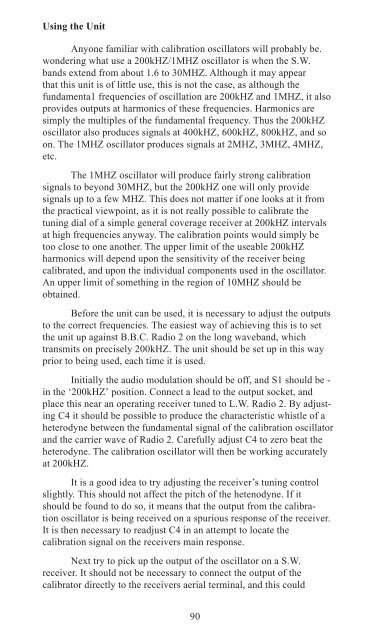Solid State Shortwave Receivers For Beginners - The Listeners Guide
Solid State Shortwave Receivers For Beginners - The Listeners Guide
Solid State Shortwave Receivers For Beginners - The Listeners Guide
You also want an ePaper? Increase the reach of your titles
YUMPU automatically turns print PDFs into web optimized ePapers that Google loves.
Using the Unit<br />
Anyone familiar with calibration oscillators will probably be.<br />
wondering what use a 200kHZ/1MHZ oscillator is when the S.W.<br />
bands extend from about 1.6 to 30MHZ. Although it may appear<br />
that this unit is of little use, this is not the case, as although the<br />
fundamenta1 frequencies of oscillation are 200kHZ and 1MHZ, it also<br />
provides outputs at harmonics of these frequencies. Harmonics are<br />
simply the multiples of the fundamental frequency. Thus the 200kHZ<br />
oscillator also produces signals at 400kHZ, 600kHZ, 800kHZ, and so<br />
on. <strong>The</strong> 1MHZ oscillator produces signals at 2MHZ, 3MHZ, 4MHZ,<br />
etc.<br />
<strong>The</strong> 1MHZ oscillator will produce fairly strong calibration<br />
signals to beyond 30MHZ, but the 200kHZ one will only provide<br />
signals up to a few MHZ. This does not matter if one looks at it from<br />
the practical viewpoint, as it is not really possible to calibrate the<br />
tuning dial of a simple general coverage receiver at 200kHZ intervals<br />
at high frequencies anyway. <strong>The</strong> calibration points would simply be<br />
too close to one another. <strong>The</strong> upper limit of the useable 200kHZ<br />
harmonics will depend upon the sensitivity of the receiver being<br />
calibrated, and upon the individual components used in the oscillator.<br />
An upper limit of something in the region of 10MHZ should be<br />
obtained.<br />
Before the unit can be used, it is necessary to adjust the outputs<br />
to the correct frequencies. <strong>The</strong> easiest way of achieving this is to set<br />
the unit up against B.B.C. Radio 2 on the long waveband, which<br />
transmits on precisely 200kHZ. <strong>The</strong> unit should be set up in this way<br />
prior to being used, each time it is used.<br />
Initially the audio modulation should be off, and S1 should be -<br />
in the ‘200kHZ’ position. Connect a lead to the output socket, and<br />
place this near an operating receiver tuned to L.W. Radio 2. By adjusting<br />
C4 it should be possible to produce the characteristic whistle of a<br />
heterodyne between the fundamental signal of the calibration oscillator<br />
and the carrier wave of Radio 2. Carefully adjust C4 to zero beat the<br />
heterodyne. <strong>The</strong> calibration oscillator will then be working accurately<br />
at 200kHZ.<br />
It is a good idea to try adjusting the receiver’s tuning control<br />
slightly. This should not affect the pitch of the hetenodyne. If it<br />
should be found to do so, it means that the output from the calibration<br />
oscillator is being received on a spurious response of the receiver.<br />
It is then necessary to readjust C4 in an attempt to locate the<br />
calibration signal on the receivers main response.<br />
Next try to pick up the output of the oscillator on a S.W.<br />
receiver. It should not be necessary to connect the output of the<br />
calibrator directly to the receivers aerial terminal, and this could<br />
90

















